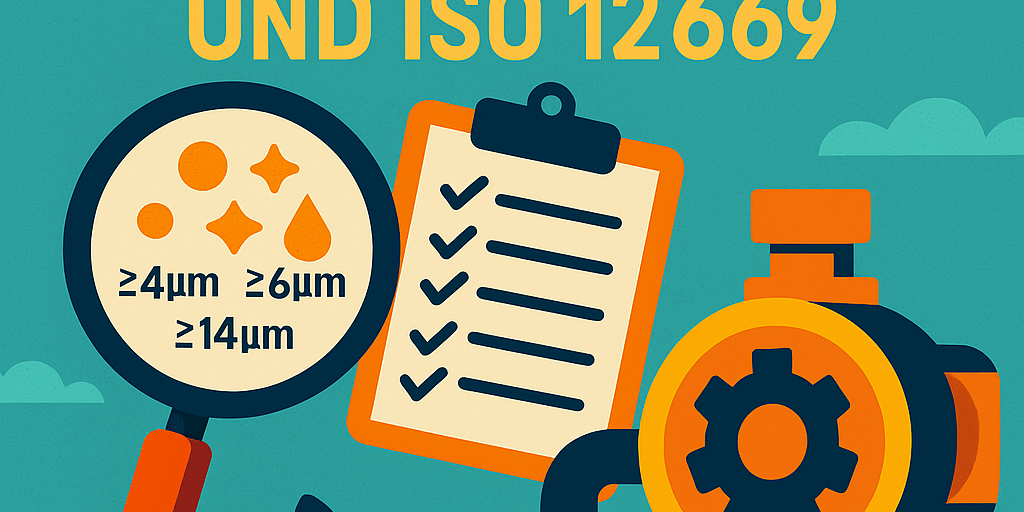What do the numbers in the ISO 4406 code actually mean—and how are they determined?
Anyone who works with hydraulic systems will sooner or later encounter the term “purity class according to ISO 4406” – often in the form of a combination of numbers such as 15/13/11.. But what do these figures actually mean in concrete terms—and how are they calculated? (Link to further articles: https://schuhmacher-tech.de/en/the-cleanliness-classes-according-to-iso-4406-important-for-oil-cleanliness/ https://schuhmacher-tech.de/oelreinheit-nach-iso-4406-18-16-13/ We provide a clear overview of how purity classes are determined and explain what really matters in practice.
🔎 What is the ISO 4406 code?
The ISO 4406 code is an internationally recognized standard for classifying the degree of solid contamination. in hydraulic fluids. The three-digit number combination (e.g., 15/13/11) describes the Concentration of particles per milliliter of oil in three different size ranges:
- ≥ 4 µm
- ≥ 6 µm
- ≥ 14 µm
The lower the value, the cleaner the oil.
🧠 How is the required cleanliness class for a system determined?
The target cleanliness class, i.e., the Required Cleanliness Level (RCL), depends on many factors and can be derived systematically—among other things, using the methodology from ISO 12669.
Essentially, it involves the systematic evaluation of six key criteria of the hydraulic system. Each of these requirements is assigned a value that assesses its sensitivity or criticality. This results in an overall weighting that can be mapped to a target cleanliness class.
📊 The six criteria for determining the required oil purity:
- Operating pressure & load cycles
The higher the pressure and the more dynamic the load (e.g., in presses or punching machines), the more sensitive the system is to particles. - Sensitivity of installed components
High-precision components such as servo valves or proportional valves are significantly more susceptible to contamination than, for example, robust gear pumps. - Planned service life of the system
Systems with a very long planned service life (e.g., > 40,000 h) generally require a higher degree of cleanliness. - Costs for component replacement
The financial expense for replacement parts also plays a role—the more expensive the components, the better the oil should be protected. - Costs due to machine downtime
When plant downtime leads to significant losses (e.g., in production lines or rolling mills), a very clean fluid is essential.
Risk to humans and the environment
In safety-critical applications—such as braking systems—there must be no risk of contamination. Particularly high requirements apply here.
📈 Practical methods for determining ISO 4406 target values
In addition to mathematical derivation, other proven methods can also be used to determine the appropriate degree of purity:
- Recommendations from component manufacturers
In most cases, the value of the most sensitive system component is used as a basis here. - Experience values from designers and specialist companies
Those who have already worked with similar systems can often derive realistic target values. - Recommendations from professional associations or research institutions
For example, based on scientific tests or industry-specific specifications. - Test runs and laboratory tests
A complex but particularly informative method—e.g., for new developments or safety-critical applications.
🟢 Conclusion: The right cleanliness class protects machines and resources.
The purity class according to ISO 4406 is not a theoretical value, but a central component for trouble-free and efficient operation of hydraulic systems.
💡 Those who derive them correctly and check them regularly not only protect their machines, but also:
- extends the service life of components,
- reduces downtime costs,
- reduces oil consumption
- and actively contributes to the conservation of resources.
🔧 Want to know if your system meets the right level of cleanliness?
We support you in selecting the right filter concept and help you optimize your oil maintenance—impartially, expertly, and practically.
📞 Contact us now or request an oil sample for analysis!
www.schuhmacher-tech.de/en/contact-us/







